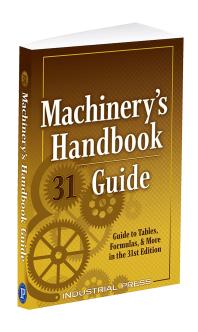
 Engineering Writing by Design (2020)
Describes how to apply engineering design concepts to the writing process Explains how engineers fall into thinking traps, and gives techniques for avoiding themrs.
Engineering Writing by Design (2020)
Describes how to apply engineering design concepts to the writing process Explains how engineers fall into thinking traps, and gives techniques for avoiding themrs.
 Machinery's Handbook Guide: A Guide to Tables, Formulas, & More in the 31st. Edition (2020)
Since the first edition published more than 100 years ago, Machinery’s Handbook has been acknowledged as an exceptionally authoritative and comprehensive, yet highly practical, and easy-to-use tool, and the new 31st edition has grown to nearly 3,000 pages. The Guide to the Use of Tables and Formulas in the Machinery’s Handbook, 31st Edition, is designed to maximize the enormous practical value of the latest, greatest edition of this invaluable engineering resource, offering useful information on how to make full use of the Machinery’s Handbook in solving problems on the job. Features Revised to reflect numerous changes made in the new 31st edition, with specific cross references to quickly locate information in the far larger book, the Guide enables users to become familiar with the Handbook’s vast range of vital content. Offering more than 150 worked-out examples and nearly 500 review questions (with answers) specially selected for engineers, apprentices, and students, the Guide addresses problems commonly encountered in manufacturing and metalworking. By following practical techniques explained in the Guide and cross-referenced to the Handbook, readers will enhance their ability to reach specific information and solutions more quickly and easily.
Machinery's Handbook Guide: A Guide to Tables, Formulas, & More in the 31st. Edition (2020)
Since the first edition published more than 100 years ago, Machinery’s Handbook has been acknowledged as an exceptionally authoritative and comprehensive, yet highly practical, and easy-to-use tool, and the new 31st edition has grown to nearly 3,000 pages. The Guide to the Use of Tables and Formulas in the Machinery’s Handbook, 31st Edition, is designed to maximize the enormous practical value of the latest, greatest edition of this invaluable engineering resource, offering useful information on how to make full use of the Machinery’s Handbook in solving problems on the job. Features Revised to reflect numerous changes made in the new 31st edition, with specific cross references to quickly locate information in the far larger book, the Guide enables users to become familiar with the Handbook’s vast range of vital content. Offering more than 150 worked-out examples and nearly 500 review questions (with answers) specially selected for engineers, apprentices, and students, the Guide addresses problems commonly encountered in manufacturing and metalworking. By following practical techniques explained in the Guide and cross-referenced to the Handbook, readers will enhance their ability to reach specific information and solutions more quickly and easily.
 Mechanical Engineering and Mechatronics Handbook (2022)
Covers basic concepts in mechanical engineering and mechatronics, including stress and strain, mechanics of solids, internal combustion engines, refrigeration, fluid mechanics, control systems, actuation, robotics, electro-mechanical systems, hydraulics, and more.
Mechanical Engineering and Mechatronics Handbook (2022)
Covers basic concepts in mechanical engineering and mechatronics, including stress and strain, mechanics of solids, internal combustion engines, refrigeration, fluid mechanics, control systems, actuation, robotics, electro-mechanical systems, hydraulics, and more.
Digital Collections:
 Engineering Your Future (2020)
This text has been updated with new references, while still maintaining a strong and practical emphasis on skills that are essential for problem solving and design.
Engineering Your Future (2020)
This text has been updated with new references, while still maintaining a strong and practical emphasis on skills that are essential for problem solving and design.
 Technical drawing 101 with AutoCAD 2015: A multidisciplinary curriculum for the first semester (2014)
Chapter one. Technical drawing -- Chapter Two. Multiview drawing -- Chapter Three. Traditional drafting tools and techniques -- Chapter Four Computer aided design basics -- Chapter Five . Dimensioning mechanical drawings -- Chapter Six. Dimensioning architectural drawings -- Chapter Seven. Isometric
Technical drawing 101 with AutoCAD 2015: A multidisciplinary curriculum for the first semester (2014)
Chapter one. Technical drawing -- Chapter Two. Multiview drawing -- Chapter Three. Traditional drafting tools and techniques -- Chapter Four Computer aided design basics -- Chapter Five . Dimensioning mechanical drawings -- Chapter Six. Dimensioning architectural drawings -- Chapter Seven. Isometric
 Schaum's outlines strength of materials, 6th edition (2014)
This all-in-one-package includes more than 600 fully solved problems, examples, and practice exercises to sharpen your problem-solving skills. ... Plus, you will have access to 22 detailed videos featuring instructors who explain the most commonly tested problems—it's just like having your own virtual tutor!
Schaum's outlines strength of materials, 6th edition (2014)
This all-in-one-package includes more than 600 fully solved problems, examples, and practice exercises to sharpen your problem-solving skills. ... Plus, you will have access to 22 detailed videos featuring instructors who explain the most commonly tested problems—it's just like having your own virtual tutor!
 Manufacturing engineering and technology (2014)
This text presents a mostly qualitative description of the science, technology, and practice of manufacturing. This includes detailed descriptions of manufacturing processes and the manufacturing enterprise that will help introduce students to important concepts
Manufacturing engineering and technology (2014)
This text presents a mostly qualitative description of the science, technology, and practice of manufacturing. This includes detailed descriptions of manufacturing processes and the manufacturing enterprise that will help introduce students to important concepts